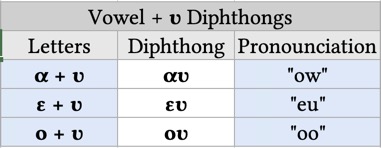Ancient Greek speakers tended to avoid pronouncing two different vowel sounds in a row. If two vowels came together, they preferred either to pronounce the two vowels together as one sound (called a DIPHTHONG, Greek for “double sound”), or to CONTRACT the two vowels to form either a single long vowel or diphthong (cf. S 59; G 5).
These sound changes are regular enough that they resemble a sort of alphabet math: vowel x + vowel y = vowel sound z. The sound-change rules below apply to a great number of nouns, adjectives, and verbs. It is therefore essential to master the rules that follow.
Specifically:
- Any vowel + ι or υ forms a diphthong.
- The vowels α, ε and ο contract with one another.
A vowel + ι forms a diphthong. The most common instances are as follows:
Note that in three cases, the resulting diphthong represents the ι as a short stroke below the first letter, e.g. ῃ instead of ηι. When the iota is so placed, it is called an IOTA SUBSCRIPT. The iota subscript can only occur when the preceding vowel is long. Iota subscripts are especially common in lower case letters.
1.6 A vowel + υ forms a diphthong. The most common instances are as follows:
1.7 The short vowels α, ε and ο regularly contracted into a long vowel or diphthong when placed next to each other.





